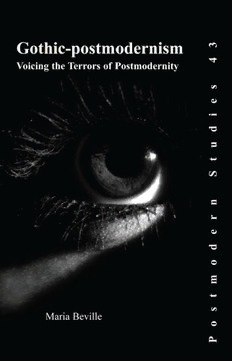
Gothic-postmodernism: voicing the terrors of postmodernity PDF
Preview Gothic-postmodernism: voicing the terrors of postmodernity
Gothic-postmodernism Postmodern Studies 43 Series edited by Theo D’haen and Hans Bertens Gothic-postmodernism Voicing the Terrors of Postmodernity Maria Beville Amsterdam - New York, NY 2009 Cover image by Mariam AlBoom Cover design: Pier Post The paper on which this book is printed meets the requirements of “ISO 9706:1994, Information and documentation - Paper for documents - Requirements for permanence”. ISBN: 978-90-420-2664-3 E-Book ISBN: 978-90-420-2665-0 ©Editions Rodopi B.V., Amsterdam – New York, NY 2009 Printed in The Netherlands Table of Contents Introduction 7 Part I: Defining Gothic-postmodernism Chapter 1 Defining Gothic-postmodernism 15 Chapter 2 On Gothic Terror 23 Chapter 3 Generic Investigations: What is ‘Gothic’? 35 Chapter 4 Postmodernism 45 Chapter 5 The Gothic and Postmodernism – At the 51 Interface Chapter 6 Gothic Literary Transformations: The Fin de 61 Siecle and Modernism Part II: Analysing Gothic-postmodernism Introduction to Part II 87 Chapter 7 The Gothic-postmodernist Novel: Three 99 Models Chapter 8 Gothic Metafiction: The Satanic Verses 125 Chapter 9 Bulgakov’s The Master and Margarita 145 Chapter 10 Textual Terrors of the Self: Haunting and 171 Hyperreality in Lunar Park Conclusion 199 Bibliography 203 Index 213 ‘But the Gothic art is sublime… it causes the whole being to expand into the infinite; earth and air, nature and art, all swell up into eternity and the only sensible impression left is that “I am nothing!”’ Samuel Taylor Coleridge ‘The General Character of the Gothic Literature and Art’ (1858) ‘It silences you… When you come down, nothing seems worth saying, nothing at all. You find the nothingness wrapping you up like a sound. Non-being.’ Alleluia Cone ‘The Satanic Verses’ (1998) Introduction In the current climate of literary experimentalism, ‘Gothic’ may seem to some, an anachronistic term. Having spent most of the nineties as a buzz-word in literature and culture, its haunting presence appears to have faded somewhat. With the end of TV serials such as Buffy the Vampire Slayer and Angel and the current lack of interest in the so- called Gothic images that used to inundate media and popular culture, the question arises yet again as to what significance the Gothic bears for contemporary literature? Having exploded in the last two decades (considered broadly as part of the postmodern era) to cross disciplinary and cultural boundaries beyond the ‘literary’ into music, film, TV, fashion and even the web, a lack of literary importance in the genre was heralded by many, who considered the intensity of the mode diluted, having been mixed with so many varieties of popular entertainment. In spite of this, the Gothic of the postmodern era continues to be analysed in detail by literary critics. Significantly, however, this analysis is mostly confined to studies of horror film and fiction and consensus tends to fall with the idea that the Gothic in postmodern literature and film is a result of a ‘diffusion’ of the genre (Botting 2003, 14). Its literary importance is regarded as having been depleted and the focus remains far from the literary, with recent popular films such as Van Helsing (2004), Blade Trinity (2004) and Underworld (2004) (Spooner 2008, 136). Importantly, what remains to be taken into account by such critics is the presence of fundamental Gothic elements in literary postmodernist texts. By this, I refer to works definable under the paradigm of postmodernism; experimental, radical and often metafictional literature which problematises the relationship between reality and fiction, reader and text. The main purpose of this book is to fill this gap in literary criticism by proposing a theoretical approach to postmodernist texts that are definitively Gothic. By defining the genre, Gothic-postmodernism, it will assert the intrinsic links that tie the Gothic and the postmodern in literary and cultural terms and declare
